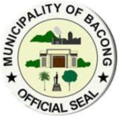Bacong | |
|---|---|
| Municipality of Bacong | |
 Municipal hall of Bacong | |
 Map of Negros Oriental with Bacong highlighted | |
 Interactive map of Bacong | |
Location within the Philippines | |
| Coordinates: 9°14′47″N123°17′41″E / 9.246367°N 123.294811°E | |
| Country | Philippines |
| Region | Negros Island Region |
| Province | Negros Oriental |
| District | 3rd district |
| Barangays | 22 (see Barangays) |
| Government | |
| • Type | Sangguniang Bayan |
| • Mayor | Lenin P. Alviola |
| • Vice Mayor | Jocelyn A. Alviola (LP) |
| • Representative | Janice Degamo (Lakas) |
| • Municipal Council | Members |
| • Electorate | 26,327 voters (2025) |
| Area | |
• Total | 40.30 km2 (15.56 sq mi) |
| Elevation | 42 m (138 ft) |
| Highest elevation | 241 m (791 ft) |
| Lowest elevation | 0 m (0 ft) |
| Population (2024 census) [3] | |
• Total | 43,889 |
| • Density | 1,089/km2 (2,821/sq mi) |
| • Households | 10,105 |
| Economy | |
| • Income class | 4th municipal income class |
| • Poverty incidence | 15.95 |
| • Revenue | ₱ 216.4 million (2022) |
| • Assets | ₱ 1,459 million (2022) |
| • Expenditure | ₱ 115.2 million (2022) |
| • Liabilities | ₱ 1,019 million (2022) |
| Service provider | |
| • Electricity | Negros Oriental 2 Electric Cooperative (NORECO 2) |
| Time zone | UTC+8 (PST) |
| ZIP code | 6216 |
| PSGC | |
| IDD : area code | +63 (0)35 |
| Native languages | Cebuano Tagalog |
Bacong, officially the Municipality of Bacong, is a municipality in the province of Negros Oriental, Philippines. According to the 2024 census, it has a population of 43,889 people. [5]
Contents
- History
- Geography
- Barangays
- Climate
- Demographics
- Economy
- Education
- Sister Cities
- References
- External links
Bacong was the hometown of the Visayan hero of the Philippine Revolution, Pantaleon Villegas, better known as León Kilat.
Bacong is 8 kilometres (5.0 mi) from Dumaguete.




